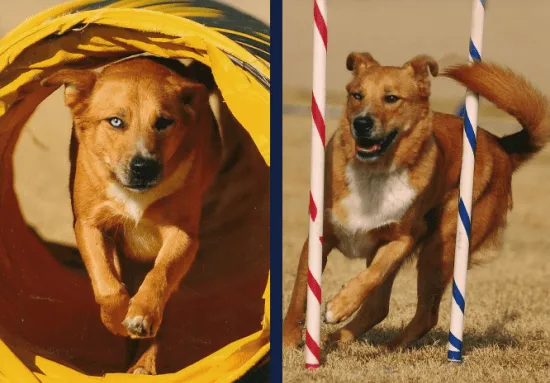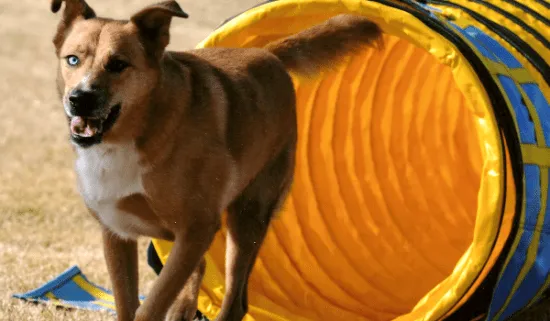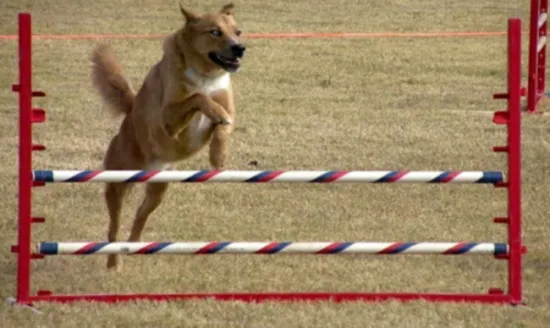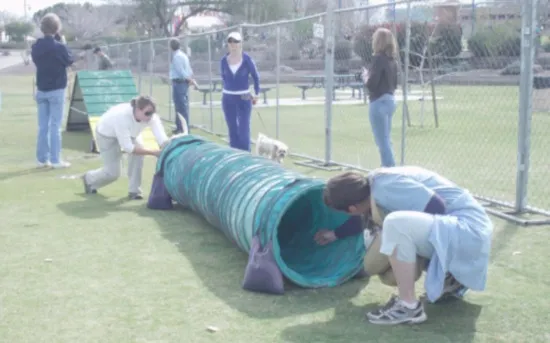Are you looking for an exciting and rewarding way to deepen the bond with your canine companion and tap into their natural athleticism? Dog agility training offers a dynamic blend of physical exercise, mental stimulation, and clear communication, transforming both you and your dog into a formidable team. This sport, rooted in a desire to showcase a dog’s speed and intelligence, has evolved into a thrilling activity that benefits dogs and their owners in numerous ways. If you’re seeking to resolve behavioral issues, provide comprehensive exercise, enhance off-leash reliability, and become a more adept communicator with your dog, then dog agility training might be your perfect fit. It’s more than just a sport; it’s about building a shared language and fostering an unbreakable partnership.

The Transformative Power of Dog Agility Training
Dog agility training is a comprehensive approach to canine enrichment that addresses multiple facets of a dog’s well-being and behavior. For owners, it’s an opportunity to develop a nuanced understanding of canine communication, relying on body language and subtle cues to guide their dog through complex courses. This heightened awareness translates into improved training across all disciplines, making you a more effective and confident handler.
Beyond the practical training benefits, agility fosters a unique connection. The shared experience of navigating obstacles and overcoming challenges together builds trust and strengthens the human-animal bond. It provides a constructive outlet for a dog’s energy, combating boredom, which is often the root of many behavioral problems. Dogs were bred to work and have a purpose, and a lack of mental and physical engagement can lead to destructive behaviors like excessive digging or incessant barking. Agility offers a fulfilling “job” for your dog, channeling their natural instincts into positive activities.
Unlike a casual stroll or even a vigorous run, agility engages a dog’s mind as well as their body. This holistic approach to exercise is crucial for preventing hyperactivity and promoting a well-balanced temperament. It teaches your dog that listening to you is not only rewarding but also leads to exciting experiences. In contrast to a dog park, where a dog might simply engage in solitary play, agility training positions you as the source of fun and guidance, solidifying your role as the dog’s most valued companion. The skills honed in agility are transferable, proving beneficial in various other dog sports and everyday training scenarios, from teaching new tricks to managing energetic puppies.

Understanding Dog Agility: What It Is and Where It Came From
At its core, dog agility is a timed obstacle course where a handler directs their dog through a pre-determined sequence of challenges. A typical course involves 12 to 18 obstacles, including tunnels, jumps of varying heights, weave poles, and the distinctive contact obstacles like the A-frame, dog walk, and teeter-totter. During a competition, the dog navigates the course off-leash, relying entirely on the handler’s non-verbal cues and voice commands. This necessitates a deep level of communication and trust between the human and canine partners.
The sport originated in England in 1978, inspired by equestrian show jumping. Initially conceived as a halftime entertainment at the prestigious Crufts dog show, its aim was to highlight a dog’s innate speed and nimbleness. The concept quickly resonated with dog owners and trainers, sparking the creation of a new and engaging canine sport.
Today, numerous organizations sanction agility trials, each with its own set of rules and course design philosophies. Prominent organizations in North America include the North American Dog Agility Council (NADAC), the American Kennel Club (AKC), and the United States Dog Agility Association (USDAA). NADAC courses often emphasize speed and distance, requiring handlers to guide their dogs from afar. USDAA courses tend to be more technically demanding and intricate. For beginners, observing a “Jumpers” course, as demonstrated in a video of a dog’s first trial, can offer a clear visual of the sport’s dynamic nature.
Who Can Participate in Dog Agility?
A significant appeal of dog agility is its inclusivity. The sport welcomes participants of all ages and fitness levels. You’ll find young children and seasoned seniors alike competing, demonstrating that agility is accessible to everyone. Similarly, physical prowess is not a prerequisite for participation. While being in good shape can be an advantage, many handlers with varying physical abilities successfully engage in agility. In fact, the sport itself can be a catalyst for improving your own fitness.
Regarding your dog, breed is not a barrier to entry. While herding breeds like Border Collies are often dominant due to their natural athleticism and trainability, dogs of all breeds and mixes can excel. From Chihuahuas to Great Danes, and various mixed breeds, many dogs find success and enjoyment in agility. Even organizations historically known for their strict purebred focus, like the AKC, now offer agility opportunities for mixed-breed dogs through programs like AKC Canine Partners.
The commitment in terms of time and finances can vary. For competitive training, a typical weekly schedule might involve a one-hour class and 15-20 minutes of daily home practice. Competitions are often held monthly during specific seasons. Financially, agility can be an investment, with costs for classes and trial entries. However, many clubs offer discounts for volunteers who help at trials, and junior handlers often benefit from reduced fees. Crucially, you don’t need to compete to enjoy the benefits of agility. Taking a few introductory classes or setting up a simple backyard course can provide immense fun and training value without the pressure of competition.

The Mechanics of an Agility Trial
Agility trials are typically weekend-long events organized by local clubs adhering to the rules of their chosen sanctioning body. Each trial features several distinct courses, or “runs.”
The initial phase of each run is the “walkthrough.” During this time, handlers meticulously study the course layout, memorizing the sequence of obstacles and strategizing their path. This visual planning is critical for a successful run. Once the walkthrough concludes, the judge and ring crew take their positions, and the first team is called to the starting line. The handler cues their dog, and they begin their timed run, aiming for speed and accuracy while minimizing faults.
While specific fault rules vary by organization, common infractions include:
- Knocking down jump bars: Ensuring jumps are cleared cleanly is paramount.
- Contact zone errors: The dog must place at least one paw on the designated colored “contact zones” on ascending and descending ramps of obstacles like the A-frame, dog walk, and teeter.
- Refusals or run-outs: Failing to attempt or correctly completing an obstacle, or taking the wrong one.
- Exceeding the time limit: Each course has a par time, and going over incurs penalties.
A run completed without any faults is termed a “qualifying run” or a “Q.” These runs earn points towards your dog’s official record, and accumulating enough points leads to earning titles – prestigious certifications that are added to your dog’s name, signifying their achievements. While placements in a trial are exciting, the consistent accumulation of Qs is key to progressing in the sport and earning titles.

Embarking on Your Dog Agility Journey
To begin your exploration of dog agility, the most effective first step is to locate a local training club. These clubs offer structured classes, opportunities to observe trials, and connect with experienced handlers who can offer guidance and support.
Finding a Local Club
Several resources can help you find a club:
- Clean Run Magazine’s Search Tool: A convenient online tool for locating agility clubs across various regions.
- Sanctioning Organization Websites: Most national and international agility organizations maintain directories of their member clubs on their websites.
Key North American Organizations:
- United States Dog Agility Association (USDAA)
- North American Dog Agility Council (NADAC)
- American Kennel Club (AKC) Agility
- Agility Association of Canada (AAC)
For those in Australia, resources include:
- Agility Dog Association of Australia (ADAA)
- NADAC Australia
In the United Kingdom, while official listings may be less common on organizational sites, resources like the listing of UK clubs on agilitynet.co.uk can be helpful. For a comprehensive global overview, the Wikipedia page on “Dog Agility Worldwide” provides an extensive list of national and international sanctioning organizations.
Attending a local agility trial is an excellent way to experience the sport firsthand and get a feel for a club’s atmosphere before committing to classes. Most trials are open to the public and held in accessible locations like parks. Handlers are typically friendly and happy to answer questions, but it’s best to approach them when they are not actively preparing for a run.
Going Solo with Agility Training
If your goal is casual fun rather than competitive advancement, you can create your own agility experience at home. Building some basic equipment and training your dog independently can be incredibly rewarding.
Important Safety Note: It is crucial to avoid having puppies or adolescent dogs jump over obstacles. Their bones are still developing, and excessive jumping can lead to serious joint damage. Consult with your veterinarian about your dog’s maturity before introducing jumping exercises. Joint maturity is typically around one year for small breeds and 18-24 months for larger breeds.
Resources for DIY Agility and Equipment:
- Build Your Own Agility Equipment: Websites like CanineCrib.com offer instructions for building simple PVC pipe agility equipment.
- Just for Fun Agility: Dogplay.com provides more ideas for homemade obstacles and backyard agility setups. Numerous YouTube videos showcase creative ways to build courses using everyday household items.
- Purchasing Equipment: Affordableagility.com is a recommended source for durable and reasonably priced agility equipment.
Recommended Reading for Beginners:
- “Introduction to Dog Agility” by Margaret Bonham
- “The Beginner’s Guide to Dog Agility”
Valuable YouTube Channels for Agility Learners:
- Agilitynerd: Offers a wealth of handling exercises.
- Pamelamarxsen’s agility videos playlist: Features agility training and other beneficial training how-tos.
Additional Online Resources:
- Discussions on safe jumping techniques.
- Articles explaining foundational concepts like “flatwork” (ground-based training).
- Websites like AgilityNerd.com and CleanRun.com offer extensive articles and training tips.
- Resources detailing agility skills that can be taught at home.
Whether you pursue agility as a lighthearted activity or as a challenging endeavor to test your and your dog’s limits, the sport is known for its addictive nature and the profound benefits it brings to the partnership between a dog and their owner.
